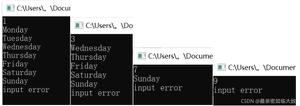C ++中范围的按位OR(或-)
在这个问题中,我们给了两个整数值a和b。我们的任务是找到从a到b的按位OR(|)。这意味着我们将不得不找到|的值。a + 1 | a + 2 | …b-1 | b。
让我们举个例子来了解这个问题,
输入− a = 3,b = 8
输出-15
说明-3 | 4 | 5 | 6 | 7 | 8 = 15
为了解决该问题,一个简单的解决方案是从a开始,然后将一个数字增加到b,以找到所有数字的按位或。
更有效的解决方案,
这是一个更有效的解决方案,可以使用-
步骤1-找到a和b的MSB位,假设它们是MSBa和MSBb。
步骤2-检查MSBa是否等于MSBb。
步骤2.1-如果MSBa和MSBb相等。做,
步骤2.1.1-将结果的MSB设置为1。
步骤2.1.2-从a和b中减去MSB,这将是a和b的新值。转到步骤1。
步骤2.2-如果MSBa和MSBb相等。做,
步骤2.2.1-将结果的所有位设置为0到max(MSBa,MSBb)。
步骤3-打印结果。
现在,让我们看看上面的算法在工作中-
示例-a = 3和b = 8。
解决方案-
步骤1-MSBa = 1; MSBb = 3
步骤2 -MSBa!= MSBb,将结果位置3到位置0的所有位设置为1. result =(1111)2 = 15。
示例
现在,让我们看一下解决问题的代码,
#include <iostream>using namespace std;
int FindpositionMSB(long long int n){
int MSBval = -1;
while (n) {
n = n>>1;
MSBval++;
}
return MSBval;
}
long int CalcBitwiseORRaneg( long int a, long int b) {
long int result = 0;
int msba = FindpositionMSB(a);
int msbb = FindpositionMSB(b);
while (msba == msbb) {
long int value = (1 << msba);
result += value;
a -= value;
b -= value;
msba = FindpositionMSB(a);
msbb = FindpositionMSB(b);
}
msba = max(msba, msbb);
for (int i = msba; i >= 0; i--) {
long int res_val = (1<<i);
result += res_val;
}
return result;
}
int main() {
long int a = 3, b = 8;
cout<<"The bitwise OR (|) of all integers in the range from "<<a<<" to "<<b<<" is "<<CalcBitwiseORRaneg(a, b);
return 0;
}
输出结果
The bitwise OR (|) of all integers in the range from 3 to 8 is 15
以上是 C ++中范围的按位OR(或-) 的全部内容, 来源链接: utcz.com/z/343393.html





